| Genus | Authors | Year | Status | Age | Location | Notes | Images |
|---|
| Abyssosaurus [3] | Berezin | 2011 | Valid | Early Cretaceous |  Russia Russia | Had a uniquely short, triangular skull with extremely large eye sockets |  |
| Acostasaurus [4] | Gómez-Pérez & Noè | 2017 | Valid | Early Cretaceous |  Colombia Colombia | Noted for its unusually caniniform dentition compared to other pliosaurids |  |
| Albertonectes [5] | Kubo et al. | 2012 | Valid | Late Cretaceous |  Canada Canada | Had the longest neck of any known plesiosaur, made up of seventy-six vertebrae |  |
| Alexandronectes | Otero et al. | 2016 | Valid | Late Cretaceous |  New Zealand New Zealand | The first aristonectine from which a stapes is known [6] |  |
| Alexeyisaurus | Sennikov & Arkhangelsky | 2010 | Dubious | Late Triassic |  Russia Russia | Although originally described as an elasmosaurid plesiosaur, it was suggested to be an undiagnostic sauropterygian taxon by subsequent analyses | |
| Alzadasaurus | Welles & Bump | 1949 | Jr. synonym | N/A | N/A | Junior synonym of Styxosaurus | |
| Anguanax [7] | Cau & Fanti | 2015 | Valid | Late Jurassic |  Italy Italy | Several features of its skull would indicate a diet of soft or small-bodied prey |  |
| Anningasaura [8] | Vincent & Benson | 2012 | Valid | Early Jurassic |  United Kingdom United Kingdom | Known from a partial skeleton belonging to a juvenile animal |  |
| Apatomerus | Williston | 1903 | Dubious? | Early Cretaceous |  United States United States | Originally identified as a crocodilian and later reinterpreted as a pterosaur, although it may very likely be a plesiosaur | |
| Aphrosaurus | Welles | 1943 | Valid | Late Cretaceous |  United States United States | Distinguished by the presence of a deepened ventral notch along the centra of its cervical vertebrae |  |
| Apractocleidus | Smellie | 1915 | Jr. synonym | N/A | N/A | Junior synonym of Cryptoclidus | |
| Aptychodon | von Reuss | 1855 | Valid | Late Cretaceous |  Czech Republic Czech Republic | Some studies suggest this genus may be a potential junior synonym of Polyptychodon |  |
| Archaeonectrus | Novozhilov | 1964 | Valid | Early Jurassic |  United Kingdom United Kingdom | Originally mistakenly believed to be a species of Plesiosaurus |  |
| Aristonectes | Cabrera | 1941 | Valid | Late Cretaceous | Antarctica
 Argentina Argentina
 Chile Chile | This genus would have migrated regularly between Patagonia and Antarctica as implied by its fossil record |  |
| Arminisaurus | Sachs & Kear | 2017 | Valid | Early Jurassic |  Germany Germany | Shares some features of its skeleton with leptocleidian plesiosauroids |  |
| Attenborosaurus | Bakker | 1993 | Valid | Early Jurassic |  United Kingdom United Kingdom | Named in honor of British broadcaster and naturalist David Attenborough |  |
| Atychodracon | Smith | 2015 | Valid | Late Triassic to Early Jurassic |  United Kingdom United Kingdom | Has been assigned to four different genera before its formal description |  |
| Avalonnectes [9] | Benson, Evans & Druckenmiller | 2012 | Valid | Early Jurassic |  United Kingdom United Kingdom | One of the oldest plesiosaurs known to date | 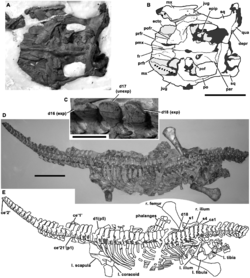 |
| Bathyspondylus | Delair | 1982 | Valid | Late Jurassic |  United Kingdom United Kingdom | Possesses an unusual mix of pliosauroid and plesiosauroid features |  |
| Bishanopliosaurus | Dong | 1980 | Valid | Early Jurassic to Middle Jurassic |  China China | Could be distinguished by the bifurcated ribs of its sacrum |  |
| Borealonectes | Sato & Wu | 2008 | Valid | Middle Jurassic |  Canada Canada | One of the few North American plesiosaurs that lived during the Jurassic | |
| Boyacasaurus [10] | Benavides-Cabra et al. | 2025 | Valid | Early Cretaceous |  Colombia Colombia | Known from two specimens found in association with ammonites | |
| Brachauchenius | Williston | 1903 | Valid | Late Cretaceous |  Morocco Morocco
 United States United States | Several pliosaurid specimens of same age had been referred to this genus, although they were either renamed as new taxa or considered dubious |  |
| Brancasaurus | Wegner | 1914 | Valid | Early Cretaceous |  Germany Germany | Its cervical vertebrae are noted for having shark fin-shaped neural spines |  |
| Brimosaurus | Leidy | 1854 | Dubious | Late Cretaceous |  United States United States | May be synonymous with Cimoliasaurus | |
| Callawayasaurus | Carpenter | 1999 | Valid | Early Cretaceous |  Colombia Colombia | Has no pectoral bars, a trait shared with Terminonatator |  |
| Cardiocorax [11] | Araújo et al. | 2015 | Valid | Late Cretaceous |  Angola Angola | The morphology of its scapula suggests a relatively unique swimming style for this genus |  |
| Ceraunosaurus | Thurmond | 1968 | Jr. synonym | N/A | N/A | Junior synonym of Trinacromerum | |
| Chubutinectes [12] | O'Gorman et al. | 2023 | Valid | Late Cretaceous |  Argentina Argentina | Larger than the contemporary Kawanectes due to its marine habitat | |
| Cimoliasaurus | Leidy | 1851 | Valid | Late Cretaceous |  United States United States | Discovered in sediments that superficially resemble the chalk deposits found in the Western Interior Seaway |  |
| Colymbosaurus | Seeley | 1874 | Valid | Middle Jurassic to Late Jurassic |  Norway Norway
 United Kingdom United Kingdom | The holotype humerus was originally misidentified as a femur |  |
| Crymocetus | Cope | 1869 | Dubious | Late Cretaceous |  United Kingdom United Kingdom | Today seen as an indeterminate plesiosaur. Only known from a single vertebra |  |
| Cryonectes [13] | Vincent, Bardet & Mattioli | 2012 | Valid | Early Jurassic |  France France | Possessed a relatively elongated snout |  |
| Cryptoclidus | Seeley | 1892 | Valid | Middle Jurassic to Late Jurassic |  United Kingdom United Kingdom | Would have preyed on small, soft-bodied animals as indicated by the delicate build of its skull and teeth |  |
| Discosaurus | Leidy | 1851 | Valid | Late Cretaceous |  United States United States | Has been argued to be the same taxon as Elasmosaurus |  |
| Djupedalia [14] | Knutsen, Druckenmiller & Hurum | 2012 | Valid | Late Jurassic |  Norway Norway | Named after former Minister of Education and Research Øystein Djupedal |  |
| Dolichorhynchops | Williston | 1902 | Valid | Late Cretaceous |  Canada Canada
 United States United States | Described two years after its discovery |  |
| Dravidosaurus | Yadagiri & Ayyasami | 1979 | Dubious | Late Cretaceous |  India India | Suggested to be either an ornithischian (potentially stegosaurian) dinosaur or a plesiosaur | |
| Eardasaurus | Ketchum & Benson | 2022 | Valid | Middle Jurassic |  United Kingdom United Kingdom | Had prominent enamel ridges in its teeth, which would indicate a diet of large prey |  |
| Edgarosaurus | Druckenmiller | 2002 | Valid | Early Cretaceous |  United States United States | One of the first polycotylids to become native to the Western Interior Seaway |  |
| Eiectus | Noè & Gómez-Pérez | 2021 | Valid? | Early Cretaceous |  Australia Australia | Potentially synonymous with Kronosaurus | |
| Elasmosaurus | Cope | 1868 | Valid | Late Cretaceous |  United States United States | Originally erroneously reconstructed with its skull placed at the end of its tail |  |
| Embaphias | Cope | 1894 | Dubious | Late Cretaceous |  United States United States | Based on three cervical vertebrae | |
| Eoplesiosaurus [9] | Benson, Evans & Druckenmiller | 2012 | Valid | Early Jurassic |  United Kingdom United Kingdom | May have been the basalmost known member of the Plesiosauroidea |  |
| Eopolycotylus [15] | Albright et al. | 2007 | Valid | Late Cretaceous |  United States United States | Known from a single partial skeleton |  |
| Eretmosaurus | Seeley | 1874 | Valid | Early Jurassic to Middle Jurassic |  Russia Russia
 United Kingdom United Kingdom | Two species are known |  |
| Eromangasaurus | Kear | 2005 | Valid | Early Cretaceous |  Australia Australia | The holotype skull is almost complete although badly crushed |  |
| Eurycleidus | Andrews | 1922 | Valid | Early Jurassic |  United Kingdom United Kingdom | May have made a powerful forward stroke for fast swimming as suggested by its relatively large shoulder bones | |
| Eurysaurus | Gaudry | 1878 | Valid | Early Jurassic |  France France | Formerly misidentified as a nothosaur | |
| Fluvionectes | Campbell et al. | 2021 | Valid | Late Cretaceous |  Canada Canada | The holotype specimen may have died in a log jam as suggested by the pieces of coalified wood found alongside it |  |
| Franconiasaurus [16] | Sachs, Eggmaier & Madzia | 2024 | Valid | Early Jurassic |  Germany Germany | Its cervical and dorsal vertebrae possessed short neural spines |  |
| Fresnosaurus | Welles | 1943 | Valid | Late Cretaceous |  United States United States | Coexisted with at least three other plesiosaurs |  |
| Futabasaurus | Sato, Hasegawa & Manabe | 2006 | Valid | Late Cretaceous |  Japan Japan | Most of its bones preserve bite marks caused by Cretalamna , indicating it would have been scavenged or hunted by the shark |  |
| Gallardosaurus | Gasparini | 2009 | Valid | Late Jurassic |  Cuba Cuba | The only known individual was discovered in a concretion in dark shale |  |
| "Georgia" | Otschev | 1976 | Preoccupied | N/A | N/A | Preoccupied by a genus of snake, later renamed Georgiasaurus | |
| Georgiasaurus | Otschev | 1977 | Valid | Late Cretaceous |  Russia Russia | The holotype skeleton was damaged during preparation of the quarry stone |  |
| Goniosaurus | Meyer | 1860 | Valid | Late Cretaceous |  Netherlands Netherlands | The striations of its tooth meet each other under an angle pointing to the root instead of the apex | |
| Gronausaurus [17] | Hampe | 2013 | Jr. synonym | N/A | N/A | Junior synonym of Brancasaurus | |
| Hastanectes [18] | Benson et al. | 2012 | Valid | Early Cretaceous |  United Kingdom United Kingdom | Originally named as a species of Cimoliasaurus |  |
| Hauffiosaurus | O'Keefe | 2001 | Valid | Early Jurassic |  Germany Germany
 United Kingdom United Kingdom | The holotype specimen is preserved lying on its back |  |
| Hydralmosaurus | Welles | 1943 | Jr. synonym | N/A | N/A | Junior synonym of Styxosaurus | |
| Hydrorion | Großmann | 2007 | Valid | Early Jurassic |  Germany Germany | Several individuals are known |  |
| Hydrotherosaurus | Welles | 1943 | Valid | Late Cretaceous |  United States United States | Multiple vertebrae were the first remains to be found. More bones had been unearthed afterwards | 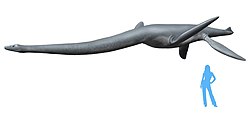 |
| Ischyrodon | von Meyer | 1838 | Dubious | Middle Jurassic |  Switzerland Switzerland | Has been considered a junior synonym of Liopleurodon , but a 2022 revision found some differences that would make it separate from that genus [19] |  |
| Jucha | Fischer et al. | 2020 | Valid | Early Cretaceous |  Russia Russia | One of the earliest known confirmed elasmosaurids |  |
| Kaiwhekea | Cruickshank & Fordyce | 2002 | Valid | Late Cretaceous |  New Zealand New Zealand | Preserved inside a large, roughly 6.5 m (21 ft) long concretion |  |
| Kawanectes [20] | O'Gorman | 2016 | Valid | Late Cretaceous |  Argentina Argentina | Previously identified as a species of Trinacromerum |  |
| Kimmerosaurus | Brown | 1981 | Valid | Late Jurassic |  Norway? Norway?
 United Kingdom United Kingdom | Its skull was overall similar to that of the related Cryptoclidus but much broader |  |
| Kronosaurus | Longman | 1924 | Valid | Early Cretaceous |  Australia Australia | One of the largest pliosaurids ever identified, likely the apex predator of its environment | 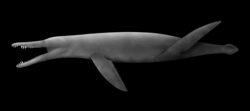 |
| Lagenanectes | Sachs, Hornung & Kear | 2017 | Valid | Early Cretaceous |  Germany Germany | One of the most well-preserved plesiosaurs known from the Early Cretaceous of Europe |  |
| Leivanectes | Páramo-Fonseca et al. | 2019 | Valid | Early Cretaceous |  Colombia Colombia | Differs from the contemporary Callawayasaurus , hence its classification as a separate genus | |
| Leptocleidus | Andrews | 1922 | Valid | Early Cretaceous |  Australia Australia
 South Africa South Africa
 United Kingdom United Kingdom | Like other members of its family and unlike most other plesiosaurs, it inhabited freshwater environments |  |
| Leurospondylus | Brown | 1913 | Valid | Late Cretaceous |  Canada Canada | Its exact taxonomic placement is uncertain |  |
| Libonectes | Carpenter | 1997 | Valid | Late Cretaceous |  Morocco Morocco
 United States United States | Originally referred to as a species of Elasmosaurus , but it was named as a distinct genus due to morphological differences |  |
| Lindwurmia | Vincent & Storrs | 2019 | Valid | Early Jurassic |  Germany Germany | Possessed five pairs of premaxillary teeth |  |
| Liopleurodon | Sauvage | 1873 | Valid | Middle Jurassic to Late Jurassic |  France France
 Germany Germany
 Mexico Mexico
 United Kingdom United Kingdom | Several analyses suggest that this genus may have been an ambush predator |  |
| Lorrainosaurus [21] | Sachs et al. | 2023 | Valid | Middle Jurassic |  France France | Originally assigned to Simolestes but it has been found to be more derived |  |
| Luetkesaurus | Kiprijanoff | 1883 | Dubious | Late Cretaceous |  Russia Russia | No species name has ever been assigned | |
| Luskhan | Fischer et al. | 2017 | Valid | Early Cretaceous |  Russia Russia | Unlike other pliosaurids, it had a slender snout, small teeth, and short tooth rows, convergent with polycotylids |  |
| Lusonectes | Smith, Araújo & Mateus | 2012 | Valid | Early Jurassic |  Portugal Portugal | The first plesiosaur named from Portugal |  |
| Macroplata | Swinton | 1930 | Valid | Early Jurassic |  United Kingdom United Kingdom | Its neck is comparatively longer than its head | 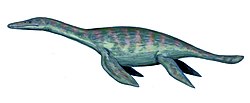 |
| Makhaira [22] | Fischer et al. | 2015 | Valid | Early Cretaceous |  Russia Russia | Unusually, its teeth were triangular in cross-section |  |
| Manemergus | Buchy et al. | 2005 | Valid | Late Cretaceous |  Morocco Morocco | May have been contemporaneous with Thililua |  |
| Marambionectes [23] | O'Gorman et al. | 2024 | Valid | Late Cretaceous | Antarctica | Closely allied to the aristonectines |  |
| Maresaurus | Gasparini | 1997 | Valid | Middle Jurassic |  Argentina Argentina | The first plesiosaur identified from the Los Molles Formation | |
| Marmornectes | Ketchum & Benson | 2011 | Valid | Middle Jurassic |  United Kingdom United Kingdom | Would have been very similar to Peloneustes | |
| Martinectes [24] | Clark, O'Keefe & Slack | 2023 | Valid | Late Cretaceous |  Russia? Russia?
 United States United States | Initially named as species of Trinacromerum and then assigned to Dolichorhynchops until its reclassification as a new genus in 2023 |  |
| Mauisaurus | Hector | 1874 | Dubious | Late Cretaceous |  New Zealand New Zealand | Several specimens had been referred to this genus, but a 2017 review restricts it only to the lectotype [25] |  |
| Mauriciosaurus | Frey et al. | 2017 | Valid | Late Cretaceous |  Mexico Mexico | Similarly to Cryptoclidus , it is noted for the unusual arrangement of gastralia |  |
| Megacephalosaurus [26] | Schumacher et al. | 2013 | Valid | Late Cretaceous |  United States United States | One of the last known pliosaurids prior to their extinction |  |
| Megalneusaurus | Knight | 1898 | Valid | Late Jurassic |  United States United States | One specimen preserves stomach contents, including cephalopods and fish |  |
| Meyerasaurus | Smith & Vincent | 2010 | Valid | Early Jurassic |  Germany Germany | Represented by a complete, articulated skeleton |  |
| Microcleidus | Watson | 1909 | Valid | Early Jurassic |  Germany Germany
 Luxembourg Luxembourg
 United Kingdom United Kingdom | Possessed at least forty vertebrae in its neck |  |
| Monquirasaurus | Noè & Gómez-Pérez | 2021 | Valid | Early Cretaceous |  Colombia Colombia | Originally known as a South American species of Kronosaurus |  |
| Morenosaurus | Welles | 1943 | Valid | Late Cretaceous |  United States United States | The only described specimen is nearly complete, missing only the skull and some parts of the neck and paddles |  |
| Morturneria | Chatterjee & Creisler | 1994 | Valid | Late Cretaceous | Antarctica | Once considered to be a juvenile Aristonectes , but a 2017 study found it to be distinct enough to warrant recognition as separate [27] |  |
| Muraenosaurus | Seeley | 1874 | Valid | Middle Jurassic |  United Kingdom United Kingdom | May have possessed an increased muscle attachment towards its neck as indicated by its elongated cervical vertebrae with broad neural spines | 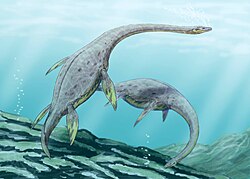 |
| Nakonanectes | Serratos et al. | 2017 | Valid | Late Cretaceous |  United States United States | Its overall morphology was exceptionally similar to that of aristonectines despite being less derived |  |
| Nichollssaura [28] | Druckenmiller & Russell | 2009 | Valid | Early Cretaceous |  Canada Canada | Fills a temporal gap of approximately 40 million years in the fossil record of North American plesiosaurs |  |
| "Nichollsia" | Druckenmiller & Russell | 2008 | Preoccupied | N/A | N/A | Preoccupied by a genus of isopod, renamed Nichollssaura | |
| Occitanosaurus | Bardet et al. | 1999 | Jr. synonym | N/A | N/A | Junior synonym of Microcleidus | |
| Ogmodirus | Williston & Moodie | 1913 | Dubious | Late Cretaceous |  United States United States | May be an elasmosaurid |  |
| Oligosimus | Leidy | 1872 | Jr. synonym | N/A | N/A | Junior synonym of Cimoliasaurus | |
| Opallionectes | Kear | 2006 | Valid | Early Cretaceous |  Australia Australia | Hypothesized to live on a cold habitat |  |
| Ophthalmothule | Roberts et al. | 2020 | Valid | Late Jurassic to Early Cretaceous |  Norway Norway | May have possibly hunted at night in deep waters as suggested by its relatively large eye sockets |  |
| Orophosaurus | Cope | 1851 | Dubious | Late Cretaceous |  United States United States | Named based only on portions of three neck vertebrae | |
| Pachycostasaurus | Cruickshank et al. | 1996 | Valid | Middle Jurassic |  United Kingdom United Kingdom | Its skeleton bears several unique features in most of the bones |  |
| Pahasapasaurus | Schumacher | 2007 | Valid | Late Cretaceous |  United States United States | Distinguishable by characters of its epipodial and palate bones |  |
| "Palmula" [15] | Albright et al. | 2007 | Preoccupied | N/A | N/A | Preoccupied by a genus of foraminifer, renamed Palmulasaurus | |
| Palmulasaurus | Albright et al. | 2007 | Valid | Late Cretaceous |  United States United States | Shared its environment with three other polycotylids |  |
| Pantosaurus | Marsh | 1893 | Valid | Late Jurassic |  United States United States | One fossil preserves a partially digested ichthyosaur embryo within its stomach cavity |  |
| Peloneustes | Lydekker | 1889 | Valid | Middle Jurassic |  United Kingdom United Kingdom | Multiple specimens are known, including fairly complete material, which make it one of the most well-known pliosaurids |  |
| Peyerus | Stromer | 1935 | Jr. synonym | N/A | N/A | Junior synonym of Leptocleidus | |
| Picrocleidus | Andrews | 1910 | Valid | Middle Jurassic |  United Kingdom United Kingdom | Previously synonymized with the coeval Muraenosaurus , but this has been cast into doubt |  |
| Piptomerus | Cope | 1887 | Jr. synonym | N/A | N/A | Junior synonym of Cimoliasaurus | |
| Piratosaurus | Leidy | 1865 | Dubious | Late Cretaceous |  Canada Canada | Solely known from a single tooth which may have come from a polycotylid |  |
| Plesioelasmosaurus | Schumacher & Everhart | 2022 | Valid | Late Cretaceous |  United States United States | Would have been relatively basal for an elasmosaurid |  |
| Plesionectes | Sachs & Madzia | 2025 | Valid | Early Jurassic |  Germany Germany | Preserved patches of soft tissue impressions that may indicate a dark coloration for this taxon |  |
| Plesiopharos | Puértolas-Pascual et al. | 2021 | Valid | Early Jurassic |  Portugal Portugal | The holotype was discovered next to a lighthouse |  |
| Plesiopleurodon | Carpenter | 1996 | Valid | Late Cretaceous |  United States United States | Initially believed to be a member of the Pliosauroidea | 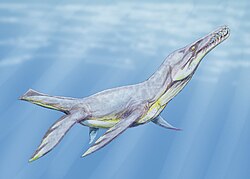 |
| Plesiopterys | O'Keefe | 2004 | Valid | Early Jurassic |  Germany Germany | Displays an unusual combination of primitive and derived traits |  |
| Plesiosaurus | De la Beche & Conybeare | 1821 | Valid | Early Jurassic |  United Kingdom United Kingdom | The first plesiosaur genus scientifically named and described. May be the most commonly found member in the Lias Group |  |
| Pliosaurus | Owen | 1841 | Valid | Late Jurassic to Early Cretaceous |  Norway Norway
 Russia Russia
 Ukraine Ukraine
 United Kingdom United Kingdom | The second specimen of P. funkei has been nicknamed "Predator X" | 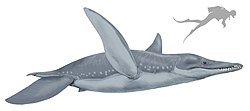 |
| Polycotylus | Cope | 1869 | Valid | Late Cretaceous |  Russia Russia
 United States United States | One particular specimen preserves a fetus inside of it, suggesting it gave live birth |  |
| Polyptychodon | Owen | 1841 | Dubious | Late Cretaceous |  Argentina? Argentina?
 France? France?
 United Kingdom United Kingdom | The sauropod dinosaur Dinodocus had been mistakenly attributed to this genus |  |
| "Raptocleidus" | Evans | 2012 | Nomen nudum | Early Jurassic |  United Kingdom United Kingdom | Two species have been named, albeit informally | |
| Rhaeticosaurus [29] | Wintrich et al. | 2017 | Valid | Late Triassic |  Germany Germany | One of the few plesiosaurs known from the Triassic | |
| Rhomaleosaurus | Seeley | 1874 | Valid | Early Jurassic |  United Kingdom United Kingdom | One of the largest early predatory marine reptiles. Four species are known |  |
| Sachicasaurus | Páramo-Fonseca et al. | 2018 | Valid | Early Cretaceous |  Colombia Colombia | One of the most completely known pliosaurids yet described |  |
| Scalamagnus [24] | Clark, O'Keefe & Slack | 2023 | Valid | Late Cretaceous |  United States United States | Once believed to be a species of Dolichorhynchops |  |
| Scanisaurus | Persson | 1959 | Dubious | Late Cretaceous |  Russia Russia
 Sweden Sweden | Although it is now considered dubious, this genus continues to be used in practice |  |
| Seeleyosaurus | White | 1940 | Valid | Early Jurassic |  Germany Germany
 Russia? Russia? | Remains originally identified as Plesiosaurus |  |
| Serpentisuchops | Persons, Street & Kelley | 2022 | Valid | Late Cretaceous |  United States United States | Had an exceptionally long neck, a unique trait among polycotylids |  |
| Simolestes | Andrews | 1909 | Valid | Middle Jurassic to Late Jurassic |  India? India?
 United Kingdom United Kingdom | Possessed an unusually short, high skull |  |
| Sinopliosaurus | Young | 1944 | Dubious | Early Cretaceous |  China China | Based only on a tooth and three vertebrae | |
| Spitrasaurus [30] | Knutsen, Druckenmiller & Hurum | 2012 | Valid | Late Jurassic |  Norway Norway
 United Kingdom? United Kingdom? | Two species have been named |  |
| Spondylosaurus | Fischer | 1845 | Jr. synonym | N/A | N/A | Junior synonym of Pliosaurus | |
| Stenorhynchosaurus | Páramo-Fonseca et al. | 2016 | Valid | Early Cretaceous |  Colombia Colombia | Originally identified as a specimen of Brachauchenius |  |
| "Stereosaurus" | Seeley | 1869 | Nomen nudum | Late Cretaceous |  United Kingdom United Kingdom | An informally named plesiosaur | |
| Sthenarosaurus | Watson | 1909 | Valid | Early Jurassic |  United Kingdom United Kingdom | Its pelvis was relatively broad and strong | 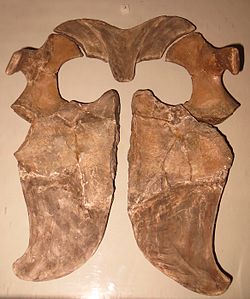 |
| Stratesaurus [9] | Benson, Evans & Druckenmiller | 2012 | Valid | Early Jurassic |  United Kingdom United Kingdom | Possibly the basalmost known rhomaleosaurid |  |
| Stretosaurus | Tarlo | 1959 | Jr. synonym | N/A | N/A | Junior synonym of Pliosaurus | |
| Strongylokrotaphus | Novozhilov | 1964 | Jr. synonym | N/A | N/A | Junior synonym of Pliosaurus | |
| Styxosaurus | Welles | 1943 | Valid | Late Cretaceous |  United States United States | Closely related to Elasmosaurus , but can be differentiated from it based on morphological features |  |
| Sulcusuchus | Gasparini & Spalletti | 1990 | Valid | Late Cretaceous |  Argentina Argentina | Originally mistakenly believed to be a pseudosuchian |  |
| Taphrosaurus | Cope | 1870 | Dubious | Late Cretaceous |  United States United States | Poorly known | |
| Tatenectes [31] | O'Keefe & Wahl | 2003 | Valid | Late Jurassic |  United States United States | Its unusual body shape and pachyostotic gastralia would have made it more suitable to turbulence |  |
| Terminonatator | Sato | 2003 | Valid | Late Cretaceous |  Canada Canada | One of the youngest plesiosaurs known from the Western Interior Seaway |  |
| Thalassiodracon | Storrs & Taylor | 1996 | Valid | Late Triassic to Early Jurassic |  United Kingdom United Kingdom | Its maxillae had heterodont dentition |  |
| Thalassiosaurus | Welles | 1953 | Jr. synonym | N/A | N/A | Junior synonym of Styxosaurus | |
| Thalassomedon | Welles | 1943 | Valid | Late Cretaceous |  United States United States | The type specimen has stones preserved in its stomach cavity |  |
| Thalassonomosaurus | Welles | 1943 | Jr. synonym | N/A | N/A | Junior synonym of Styxosaurus | |
| Thaumatodracon | Smith & Araújo | 2017 | Valid | Early Jurassic |  United Kingdom United Kingdom | Relatively large for a rhomaleosaurid | |
| Thaumatosaurus | von Meyer | 1841 | Jr. synonym | N/A | N/A | The holotype is dubious and not diagnostic, as it can be referred to as an indeterminate pliosauroid. The specimens that were assigned to this genus now belong to different taxa | |
| Thililua | Bardet, Suberbiola & Jalil | 2003 | Valid | Late Cretaceous |  Morocco Morocco | The first polycotylid plesiosaur named from Africa |  |
| Traskasaura [32] | O'Keefe et al. | 2025 | Valid | Late Cretaceous |  Canada Canada | Before its formal scientific description, it has been variously referred to as the "Courtenay elasmosaur", "Puntledge elasmosaur", or "Haslam elasmosaur". Officially recognized as the Provincial Fossil of British Columbia |  |
| Tremamesacleis | White | 1940 | Jr. synonym | N/A | N/A | Junior synonym of Muraenosaurus | |
| Trematospondylus | Quenstedt | 1858 | Dubious | Middle Jurassic |  Germany Germany | One of the first described plesiosaurs. Known only from seven large vertebrae | |
| Tricleidus | Andrews | 1909 | Valid | Middle Jurassic |  United Kingdom United Kingdom | One referred species has been later found to belong to Colymbosaurus [33] |  |
| Trinacromerum | Cragin | 1888 | Valid | Late Cretaceous |  Canada Canada
 United States United States | May have preyed on small fish as suggested by its dentition |  |
| Tuarangisaurus | Wiffen, Wiffen & Moisley | 1986 | Valid | Late Cretaceous |  New Zealand New Zealand | Possesses two features in its skeleton that are otherwise unknown in other elasmosaurids |  |
| "Turneria" | Chatterjee & Small | 1989 | Preoccupied | N/A | N/A | Preoccupied by a genus of ant, renamed Morturneria | |
| Umoonasaurus | Kear, Schroeder & Lee | 2006 | Valid | Early Cretaceous |  Australia Australia | Uniquely for a plesiosaur, its skull features three crest-ridges that were likely covered in keratin |  |
| Unktaheela [24] | Clark, O'Keefe & Slack | 2023 | Valid | Late Cretaceous |  United States United States | The smallest adult polycotylid yet known |  |
| Uronautes [34] | Cope | 1876 | Dubious | Late Cretaceous |  United States United States | Described as a rhomaleosaurid but its extremely late age casts doubt into this | |
| Vectocleidus [18] | Benson et al. | 2012 | Valid | Early Cretaceous |  United Kingdom United Kingdom | Previously thought to belong to its relative Leptocleidus |  |
| Vegasaurus [35] | O'Gorman et al. | 2015 | Valid | Late Cretaceous | Antarctica | May be closely related to Morenosaurus |  |
| Vinialesaurus [36] | Gasparini et al. | 2002 | Valid | Late Jurassic |  Cuba Cuba | Originally referred to as a species of Cryptoclidus , but it was distinct enough from that genus to be named as its own taxon |  |
| Westphaliasaurus | Schwermann & Sander | 2011 | Valid | Early Jurassic |  Germany Germany | Known from an articulated, almost complete skeleton |  |
| Woolungasaurus | Persson | 1960 | Dubious | Early Cretaceous |  Australia Australia | Today considered an indeterminate elasmosaurid |  |
| Wunyelfia | Otero et al. | 2021 | Valid | Late Cretaceous |  Chile Chile | One of the few Patagonian plesiosaurs described from outside Argentina | 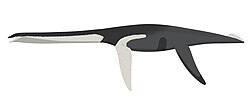 |
| Yuzhoupliosaurus [37] | Zhang | 1985 | Valid | Middle Jurassic |  China China | Distinguishable by its long coracoids and well-developed clavicles | |
| Zarafasaura | Vincent et al. | 2011 | Valid | Late Cretaceous |  Morocco Morocco | Unlike other elasmosaurids, its skull was unusually short |  |
|